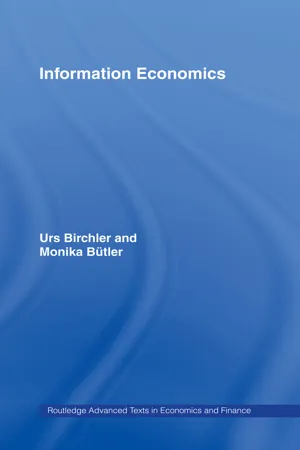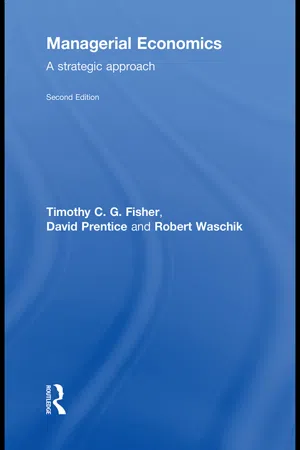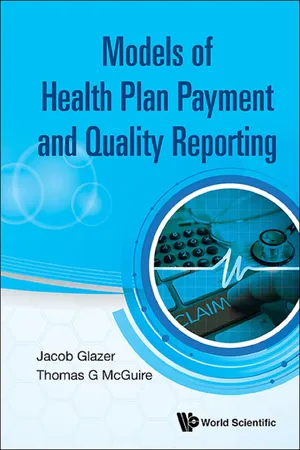Economics
Adverse Selection Examples
Adverse selection refers to a situation where one party in a transaction has more information than the other, leading to a selection of undesirable or high-risk choices. Examples include insurance applicants with higher risk of claims being more likely to seek coverage, and used car sellers withholding information about a vehicle's history. These examples illustrate how asymmetric information can lead to adverse outcomes in economic transactions.
Written by Perlego with AI-assistance
Related key terms
7 Key excerpts on "Adverse Selection Examples"
- eBook - ePub
- Weiying Zhang(Author)
- 2017(Publication Date)
- Routledge(Publisher)
8Adverse selection, brands, and regulationAsymmetric information can be classified into ex-ante asymmetric information and ex-post asymmetric information. Ex-ante asymmetric information leads to adverse selection. Ex-post asymmetric information leads to moral hazard.So-called adverse selection refers to the bad driving out the good because of asymmetric information. For example, bad cars cause good cars to not sell, high-risk policy holders cause low-risk policy holders to be uninsured, low-quality projects cause high-quality projects to be unfinanced, fake beggars cause real beggars to be neglected, high-quality scholars cannot complete with low-quality scholars, etc.Adverse selection means a potential Pareto efficiency cannot appear. In essence, it is also a Prisoner’s Dilemma issue. Resolving adverse selection to realize a Pareto efficiency is a big issue faced by society. Methods to resolve adverse selection include both market mechanisms and non-market mechanisms.Market mechanisms include: (1) The party without private information directly collects and investigate the information; (2) specialized providers of information collect and transmit information; (3) the party without private information indirectly obtains information through mechanism design; (4) the party with private information signals private information with some costs; and (5) the reputation mechanism.The reputation mechanism primarily manifests as the party with private information establishing a brand. The value of brands depends on the degree of asymmetric information. The brand of products with more asymmetric information are worth more. The value of brands is also related to income levels and technological progress. The higher incomes are, and the more complex technology is, the more important brands are.Government regulation is the primary non-market mechanism to resolve adverse selection. However, recent theoretical and empirical studies have shown that government regulation is not an effective means of resolving adverse selection. Asymmetric information more easily leads to government failure rather than market failure. - eBook - ePub
The Soulful Science
What Economists Really Do and Why It Matters - Revised Edition
- Diane Coyle(Author)
- 2009(Publication Date)
- Princeton University Press(Publisher)
Take an area where information is central to the economic decision, the market for insurance. You know that you smoke and I, an insurance company, don’t know. This information is key to my pricing your life insurance policy correctly. You have an incentive to seek life insurance cover because your risk of death is increased, but also an incentive to lie in order to pay a lower premium. Knowing this in the abstract, I will assume that some of my customers are lying and will price the policy a bit higher than I’d need to if everyone told the truth. At this higher premium, some nonsmokers will decide not to take out a policy: the price is too high given their objective probability of fatal illness. The proportion of my customers who are lying smokers will increase, and I’ll need to increase the premium again.This is the dynamic of adverse selection. The essence of it is that one party to a transaction has an incentive not to disclose private information, leaving their willingness to transact (to buy insurance or sell a used car or work for a given wage) as the only information available to the other party. In the extreme, adverse selection can cause markets to collapse, so economies have devised many ways of addressing the problem. For example, insurers will require customers to fill out long questionnaires about their health, will cross-check databases, and will invalidate policies discovered to have been taken out on the basis of false information. But the market itself, the willingness of both parties to undertake a transaction at a certain price, does not provide incentives for the disclosure of private information.Adverse selection arises when there is an asymmetry of information prior to a transaction—before you purchase your insurance policy. There is a mirror problem which arises with regard to behavior after the transaction. We might start out with the same information but afterwards there’s an asymmetry arising from the fact that I can’t monitor your behavior. This is known as moral hazard. Moral hazard describes a divergence in incentives between the two parties to a transaction. In the case of insurance, buying cover for your household goods might make you careless about taking care of them. Insurers respond by charging a lower premium for people willing to accept a larger “excess,” the amount of loss they must cover for themselves before making a claim on the policy. Countries which know the IMF will bail them out of a financial crisis might be less careful about running stable macroeconomic policies. Banks that know they will be bailed out by the government, in order to protect depositors, will have an incentive to make too many risky loans: in fact, far, far too many, so that the resulting losses will be large enough to induce a bailout rather than so small that they can be covered by a reduced dividend to shareholders.5 - eBook - ePub
The Laws of Trading
A Trader's Guide to Better Decision-Making for Everyone
- Agustin Lebron(Author)
- 2019(Publication Date)
- Wiley(Publisher)
only definitive legal document detailing the terms of the rights issue, apparently the published prospectus was wrong. The rights issue was in fact one old share for two rights, each right gives one new share.In a remarkable coincidence, it turns out that the market maker with whom Jeff had traded was also the same investment bank who underwrote the rights issue for the Greek bank, and who wrote the typo-filled prospectus. The upshot from this series of events is that Jeff discovered another source of adverse selection aptly summed up in a sports metaphor: “The goalposts have moved.” The takeaway: do not trade a contract with someone who can apparently retroactively change the terms of the contract to suit them.Adverse Selection in Everyday Life
The law about never being happy with the size of a trade may not seem like it bears much relevance to situations outside trading, but you'll see that it does indeed. The rule is a way of describing the phenomenon of adverse selection, and this phenomenon occurs in very nearly every environment where people trade and negotiate with one another. The classic example of adverse selection in everyday life concerns the market for used cars, as famously described in George Akerlof's Nobel Prize–winning work (Akerlof, 1970 ). However, adverse selection appears in many other situations, and each one teaches something a bit new about how to deal with it.eBay and the Winner's Curse
Perhaps the most obvious place where adverse selection predominates is in eBay-style auctions. In these auctions, the eventual buyer of an item is the person who bid the highest for it. That is, she beat out all the other bidders for the right to purchase the item. This is a classic situation where the winner's curse appears. The winner's curse is a well-known game theoretic phenomenon where, under very broad assumptions, the winner of a multi-bidder auction is extremely likely to have overpaid for the item.The basic idea is that there is uncertainty about the true fair value of an item. Every bidder has a different estimate of the value, and absent any other knowledge we expect the mean of these estimates to be close to the true value. The winner of the auction is the person with the highest estimate, and so is likely to have paid more than the fair value for the item. So how do you combat this phenomenon? - eBook - ePub
- Urs Birchler, Monika Bütler(Authors)
- 1999(Publication Date)
- Routledge(Publisher)
95 They are essential to avoid "no trade" scenarios. If a private trading motive is stronger than the potential fear of losing in a deal with an insider, trade occurs despite asymmetric information.Problems of self-selection are particularly important in the insurance sector. The insurance destruction effect is an example where more (private or public) information may reduce welfare from an ex ante point of view. In health insurance, for example, the availability of tests for conditions like the presence of a faulty gene may destroy the possibility of insurance against carrying the gene. The ever growing possibilities of genetic testing are a mixed blessing, therefore.But even without formal tests, selection problems exist. Individuals can make a good guess of their life expectancy or of their health risks. Puzzlingly, such private information leads to adverse selection in some markets (annuities and health insurance), but not in closely related markets, such as life insurance. The explanation seems to lie in a correlation between individual risk and insurance demand. When the better risks have a high demand for insurance, self-selection may be beneficial rather than adverse. When the bad risks have a lower demand for insurance, or lower wealth, difficult problems of public policy arise. One example is the subsidization of bad risks (long-lived professors) by the good risks (short-lived construction workers) in a pension fund.There is a wealth of literature, theoretical and empirical, on hidden information. For a more detailed treatment of the theory we suggest Laffont (1993) and Mas-Colell, Whinston and Green (1995). Wolfstetter (1999) shows the links between hidden information, general microeconomics, and auction theory. Bolton and Dewatripont (2005) treat hidden information as a background for optimal contracting, our next subject to be discussed in Chapter 14 - eBook - ePub
Managerial Economics
A Strategic Approach
- Robert Waschik, Tim Fisher, David Prentice(Authors)
- 2010(Publication Date)
- Routledge(Publisher)
If the manager offers a high wage, both high- and low-ability welders will apply for the job. In particular, the fact that the welder’s type is hidden from the manager has created an incentive for low-ability welders to apply for the job. The manager must choose, effectively at random, from the applicants and she may end up hiring a low-ability welder. The manager, who cannot observe type, faces a labour market with an adverse selection of employees to choose from. More generally, a market is said to have an adverse selection problem if parties of a particular type, detrimental to the returns to the uninformed party, participate disproportionately in the market, compared with a market in which there is complete information. The outcome of this game between employer and employee may also be affected by the fact that the employer can anticipate the adverse selection problem, just as the rental agreement in the moral hazard game took into account the informational asymmetry between the landlord and the tenant. For example, the employer may decide to hire the employee on a temporary basis at first, for some limited period of time and then evaluate the employee’s performance. If after two months the employer is satisfied with the employee’s work, she can decide to hire the welder on a permanent basis. 2 Adverse selection and health insurance It has been hypothesized that markets with adverse selection problems may ultimately fail completely. This hypothesis has been explored in the health insurance industry. The process by which firms shrink and then fail has been described as a death spiral. This can occur as follows. In health insurance markets, consumers have information about their health that the insurance company cannot observe. The insurance company sets a price for insurance and those consumers with greater health risks are over-represented in the customers of the company - Jacob Glazer, Thomas G McGuire(Authors)
- 0(Publication Date)
- WSPC(Publisher)
Another form of adverse selection takes place when a health plan discriminates in favor of or against particular applicants. If a plan knows that the expected costs of an applicant are different from the premium the plan gets if the person joins, the plan may encourage or discourage that individual from joining. An extreme example is simply denying enrollment to an applicant likely to be unprofitable. Seeking favorable risks is often referred to as “cream skimming” (see van de Ven and van Vliet, 1992), whereas seeking to shed bad risks is called “dumping” (Ching-to Albert Ma, 1994; Randall P. Ellis, 1998). Regulation can forbid these risk-selection activities, by, for example, requiring open enrollment, but subtle forms of risk selection of this form are probably hard to eradicate.The presence of adverse selection in health insurance has been recognized for a long time, and evidence continues to accumulate attesting to its empirical importance. Data from the federal Medicare program indicate that the typical Medicare beneficiary joining a managed-care plan has costs 35 percent lower in the year before joining than his/her nonjoining counterpart; the typical beneficiary leaving a plan has costs 60 percent higher than a nonjoiner (Physician Payment Review Commission, 1997). In the case of a private employer, David M. Cutler and Sarah Reber (1998) contend that the most generous plan fell victim to an adverse-selection-induced “premium death spiral.” At the same time, there have been few formal analyses of adverse selection in a context of competing health plans, and of the role of risk adjustment in correcting misallocations. Cutler and Richard Zeckhauser (1998), in an environment without risk adjustment, analyze the employer’s problem of setting contributions to health plan choices, when employees differ in their costs and in their tastes for more- or less-generous plans. Plans’ characteristics are regarded as given, and enrollment prices are assumed to be set by plans at the average cost of all enrollees in a plan. Employees joining a plan pay the difference between the plan’s average cost and the employer’s contribution to the plan. The efficiency issue addressed in that paper is how the employer’s subsidy policy serves enrollees’ taste to sort among more- or less-generous plans. In an observation akin to Greenwald and Stigliz (1986), Cutler and Zeckhauser note the efficiency value of an employer contribution that varies with plan generosity. Subsidizing expensive plans substitutes for risk adjustment, because it ends up paying more for more-expensive employees who tend to choose the generous plan. Tracy Lewis and David Sappington (1996) consider the incentives to cream skim when a health plan may gain private information about a person’s health risk by incurring a screening cost. If this screening cost is sufficiently low, Lewis and Sappington show that it will be optimal for the principal to offer a menu of contracts to the plan to induce the plan to reveal the true “type” of its enrollees. Their analysis applies to a much different information structure and regulatory environment than that considered here.- eBook - ePub
- Chris Jones(Author)
- 2008(Publication Date)
- Routledge(Publisher)
This is referred to as the mutuality principle that holds in all the consumption-based asset pricing models examined earlier in Chapter 4. We look at insurance with common (symmetric) information in Section 5.1 and then extend the analysis by introducing asymmetric information in Section 5.2. Consumers will fully insure against individual risk in a frictionless competitive equilibrium when traders have common information and state-independent preferences. We use this as a benchmark to identify the effects of trading costs and asymmetric information. Consumers choose not to fully insure when trading costs raise the price of insurance above the probability of incurring losses. When they are minimum necessary costs of trade the competitive equilibrium outcome is Pareto efficient, where expected security returns rise to compensate consumers for the cost of eliminating individual risk from their consumption expenditure. A number of government policies, including price stabilization schemes and publicly funded insurance, are justified as ways to overcome the effects of asymmetric information on private insurance. Moral hazard and adverse selection are the most widely cited problems. With moral hazard consumers have the ability to reduce their individual risk by undertaking costly self-protection. Whenever marginal effort, which cannot be observed by insurers, is not reflected in the price consumers pay for insurance, they less than fully insure. Adverse selection occurs when there are consumers with different probabilities of incurring losses that insurers cannot costlessly identify and separate. Low-risk types suffer from highrisk types buying low-risk policies. This imposes externalities on low-risk consumers. At one extreme high-risk types may prove too big a problem for the existence of a private insurance market. These are the most common reasons cited for incomplete insurance markets
Learn about this page
Index pages curate the most relevant extracts from our library of academic textbooks. They’ve been created using an in-house natural language model (NLM), each adding context and meaning to key research topics.






